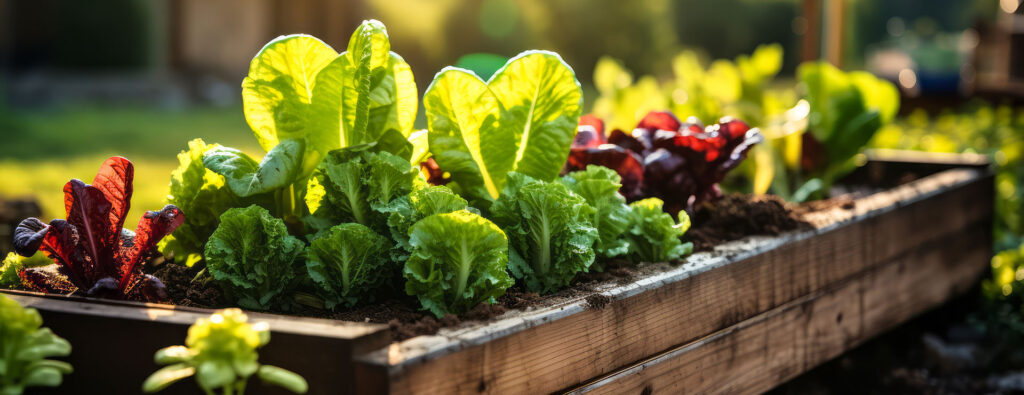An edible garden is specifically designed for growing fruits, vegetables, herbs, and other plants for personal consumption. Its popularity has surged due to increasing concerns about food safety and quality and a desire for sustainability and self-sufficiency. The pandemic further accelerated this trend as people sought therapeutic outlets and opportunities to connect with nature while spending time at home.
It’s essential to understand the importance of proper edible garden watering to ensure that your landscape remains healthy and thriving. In this article, we’ll explore four critical tips to help your plants produce a bountiful harvest of fresh, nutritious produce.
1. Choose the Right Watering Techniques
Choosing the right watering technique for your garden ensures adequate hydration while minimizing water waste. Here are some common methods to consider:
Hand Watering
Hand watering is a manual technique that uses a watering can or hose to deliver water directly to the soil. It allows for precise water control, making it ideal for small plants or areas with diverse watering needs. This method is particularly useful for newly planted seedlings and transplants, as it enables gardeners to provide individual attention to each plant’s water requirement.
Drip Irrigation
Drip irrigation delivers water directly to plant roots through a network of tubes, pipes, and emitters. This helps reduce evaporation and runoff, ultimately minimizing water waste. Depending on the garden’s layout and design, this system can be installed above ground or buried under a layer of mulch or soil. It can be customized to accommodate different plant types and water requirements and is well-suited for larger garden plots or areas with limited water availability.
Soaker Hoses
Soaker hoses are porous hoses made of rubber or recycled materials. They are buried under a layer of mulch or soil, releasing water slowly and evenly along their length. This provides consistent moisture directly to the soil around the plant’s roots without wetting the foliage. These hoses efficiently water garden beds, rows of plants, or other areas with consistent planting patterns.
Overhead Sprinklers
Overhead sprinklers distribute water from pipes and sprinkler heads above the ground. They’re popular for large garden plots or lawns, covering a wide area quickly and efficiently. However, they may be less precise and efficient than drip or soaker systems and can lead to water waste through evaporation and runoff. They may also increase the risk of foliar diseases by creating an overly humid environment on leaves. While convenient, using them responsibly to conserve water and promote healthy plant growth is essential.
2. Optimize Watering Schedules
It’s crucial to establish a regular watering schedule to achieve healthy plant growth. Watering your garden in the morning is best to allow the water to reach the roots without evaporating immediately. The midday heat will also ensure that leaves and excess water dry off before nightfall, preventing root rot and foliage diseases. Don’t forget to adjust your watering schedule with seasonal changes to avoid over- or under-hydrating your plants.
3. Adjust Watering Amounts
Your plants’ specific water needs depend on various factors such as plant species, growth stage, weather conditions, and soil type. For instance, young seedlings and transplants require more frequent watering to establish healthy root systems, while mature plants need less but deeper irrigation. Always be mindful of temperature, humidity, and precipitation fluctuations affecting your garden’s water requirements. You can also use a rain gauge or moisture meter to track soil moisture and adjust watering amounts. Generally speaking, landscapes and trees prefer deeper watering, in less frequent amounts. Depending on the summer heat and rainfall for example, it is more ideal to water 1-2 times per week, but for a much longer period, then every day, for short periods of time. Deep watering reduces stress on plants and saves on water usage.
4. Implement Efficient Watering Strategies
Other strategies you can use to optimize edible garden watering and promote a thriving ecosystem include:
- Mulching: Mulch helps keep the soil moist, so you don’t have to water it as often. Also, it suppresses weed growth, preventing competition for nutrients and water.
- Rainwater harvesting: This strategy provides your garden with a free and sustainable water source. It is also healthier than tap water, as it is free of chlorine and other purifying chemicals that can be harsh to some plants.
- Companion planting: Planting certain plants together can help maximize the efficiency of your garden space. For instance, pairing deep-rooted vegetables with shallow-rooted herbs can prevent competition for water and nutrients while promoting biodiversity. It also creates a more humid environment for plants that require elevated moisture levels in the air.
Ensure Successful Edible Garden Watering With Well Rooted Gardens
If you need help establishing a space for your edible garden, consult the experts at Well Rooted Gardens! We’ll design an edible landscape incorporating vines, shrubs, and fruit trees, making your property functional and beautiful. We offer a variety of services, from garden planting, tree care, landscape maintenance and cleaning, to hardscape solutions.
Reach out to us at 402-800-7389 today!

